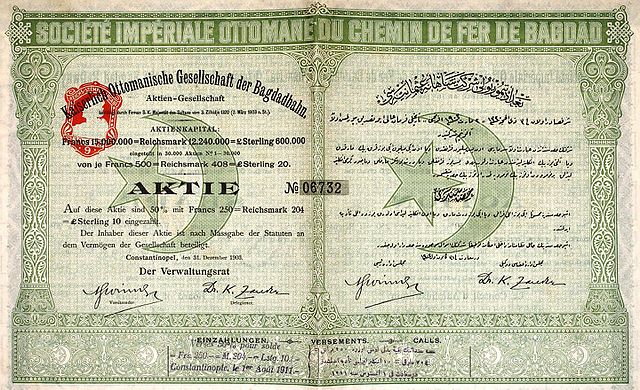巴格達鐵路
柏林至巴格达铁路 来自维基百科,自由的百科全书
巴格達鐵路(英語:Baghdad railway,土耳其語:Bağdat Demiryolu,德語:Bagdadbahn,阿拉伯語:سكة حديد بغداد,法語:Chemin de Fer Impérial Ottoman de Bagdad),又稱「柏林-巴格達鐵路」,是一條由1903年至1940年間興建,連接柏林與當時鄂圖曼帝國巴格達的鐵路,以便德國人在波斯灣建立港口[2],當中有1600公里路線通過現時土耳其、敘利亞和伊拉克地區。

工程的完工花了幾十年,到了第一次世界大戰爆發時,鐵路仍距離目標超過960公里。最後到達巴格達的鐵路在1930年代末興建,而首班由伊斯坦堡到巴格達的列車在1940年開行。
資金、工程和建設主要由德意志帝國的主要銀行德意志銀行和公司菲利普·霍茲曼提供,該公司在1890年代興建了安納托利亞鐵路,連接君士坦丁堡、安卡拉和科尼亞。鄂圖曼帝國希望維持控制阿拉伯半島,並擴展其影響力到紅海,到名義上屬於鄂圖曼(直至1914年)的埃及赫迪夫,但本身自1882年烏拉比叛變後就受英國軍事統治。如果鐵路完工,德國將可取得美索不達米亞的疑似油田[3],同時也連接波斯灣的巴斯拉港。後者將可為德國殖民帝國東部提供直接連結,並避開了由英法控制的蘇伊士運河。
鐵路在第一次世界大戰後馬上成為一系列國際紛爭的來源[4][5]。雖然有人認為這些紛爭在1914年戰爭開始前已經解決,但也有人認為鐵路本身是第一次世界大戰爆發原因[6][7]。托魯斯山脈遇上的技術困難和外交問題意味着到了1915年鐵路仍有480公里未興建,嚴重限制了戰爭期間英國佔領巴格達時的用處,而南面的漢志鐵路則被湯瑪斯·愛德華·勞倫斯帶領的游擊隊攻擊。工程在1930年代恢復並在1940年完工。
參見
- 伊拉克共和國鐵路
延伸閱讀
- Chéradame, André. The Baghdad Railway. London: Central Asian Society, 1911. OCLC 52087046
- Peter Christensen. Germany and the Ottoman Railways: Art, Empire, and Infrastructure (Yale University Press, 2017)[8]
- Corrigan, H. S. W., "German-Turkish Relations and the Outbreak of War in 1914: A Re-Assessment". Past and Present, No. 36 (April 1967), pages 144–152.
- Earle, Edward Meade, Turkey, The Great Powers, and the Bagdad Railway. Russel and Russel (1923; reprint: 1966).
- R. J. W. Evans and Hartmut Pogge Von Strandman, eds. The Coming of the First World War – Oxford UP 1990
- Hughes, Hugh, Middle East Railways Harrow, The Continental Railway Circle, 1981. ISBN 0-9503469-7-7
- Jastrow, Jr., Morris, The War and the Bagdad Railway. 1917. ISBN 1-4021-6786-5 (electronic copy)
- Engdahl, William, A Century of War: Anglo-American Oil Politics and the New World Order. ISBN 0-7453-2310-3
- Henig, Ruth, The Origins of the First World War. Routledge. 1989, 2nd edition: 2002.
- Khairallah, Shereen, Railways in the Middle East 1856–1948 (Political and Economic Background) . Beirut, Librarie du Liban, 1991. ISBN 1-85341-121-3
- Maloney, Arthur P. The Berlin-Baghdad Railway As a Cause of World War I. Alexandria, Va: Center for Naval Analyses, Naval Studies Group, 1984. OCLC 10818256
- Sean McMeekin, "The Berlin-Baghdad Express: The Ottoman Empire and Germany's Bid for World Power", Harvard University Press, Cambridge, MA 2010.
- McMurray, Jonathan S. "Distant Ties: Germany, the Ottoman Empire, and the Construction of the Baghdad Railway", Westport, CT 2001. ISBN 0-275-97063-9.
- The Construction of the Baghdad Railway and its Impact on Anglo-Turkish Relations, 1902–1913. Mustafa Sıtkı BİLGİN
- Somerwil-Ayrton, Kathie. The Train That Disappeared into History: The Berlin-to-Bagdad Railway and How It Led to the Great War. Soesterberg, Netherland: Uitgeverij Aspekt, 2007. ISBN 978-90-5911-573-6 OCLC 227331940
- Pongiluppi Francesco, The Energetic Issue as a Key Factor of the Fall of the Ottoman Empire, in "The First World War: Analysis and Interpretation" (edited by Biagini and Motta), Vol. 2., Cambridge Scholars Publishing, Newcastle, 2015, pp. 453–464.
- Wolf, John B. The Diplomatic History of the Bagdad Railroad. Columbia: The University of Missouri, 1936. OCLC 2495942
- Mehmet Besirli: Die europäische Finanzkontrolle im Osmanischen Reich der Zeit von 1908 bis 1914. Die Rivalitäten der britischen, französischen und deutschen Hochfinanz und der Diplomatie vor dem ersten Weltkrieg am Beispiel der türkischen Staatsanleihen und der Bagdadbahn. Berlin 1999.
- Benno Bickel: Mit Agatha Christie durch die Schluchten des Taurus. Die Bagdadbahn im Spiegel der Literatur und des Reiseberichts, in Jürgen Franzke (Hrsg.): Bagdadbahn und Hedjazbahn. Deutsche Eisenbahngeschichte im Vorderen Orient. Nürnberg 2003, pages 120-124. ISBN 3-921590-05-1
- Benno Bickel: Zeittafel Bagdadbahn, in: Jürgen Franzke (Hrsg.): Bagdadbahn und Hedjazbahn. Deutsche Eisenbahngeschichte im Vorderen Orient. Nürnberg 2003, pages 160-162. ISBN 3-921590-05-1
- Jgnaz Civelli: Deutsche Schienen in osmanischem Boden. Eine virtuelle Reise mit der Anatolischen und Bagdadbahn durch Geschichte, Wahrnehmungen, Raum und Zeit. Fachbuch, 266 Seiten. Zofingen / Zug 2010. ISBN 978-3-640-59495-5.
- Lothar Groß Made in Germany: Deutschlands Wirtschaftsgeschichte von der Industralisierung bis heute Band 1: 1800–1945, Books on demand, 2012, ISBN 978-3-8482-1042-8
- Peter Heigl, Schotter für die Wüste. Die Bagdadbahn und ihre deutschen Bauingenieure, Nürnberg 2004. ISBN 3-00-014268-1
- Jürgen Lodemann: Mit der Bagdadbahn durch unbekannte Türkei. Tagebuch einer preiswerten Reise, Eggingen 1990. ISBN 3-925016-62-7
- Johann Manzenreiter, Die Bagdadbahn als Beispiel für die Entstehung des Finanzimperialismus in Europa (1872–1903) = Bochumer historische Studien, Neuere Geschichte, 2, Bochum 1982.
- Helmut Mejcher, Die Bagdadbahn als Instrument deutschen wirtschaftlichen Einflusses im Osmanischen Reich, in: Geschichte und Gesellschaft 1 (1975), pages 447-481.
- Johannes Müller, Syrien und die Hedschasbahn = Dampf und Reise / Überseeische Eisenbahnen. 1/1989.
- Erika Preissig und Günther Klebes, Eisenbahnbau und Eisenbahnprojekte im Orient und die damit verfolgten wirtschaftlichen und politischen Ziele, in: Jahrbuch für Eisenbahngeschichte 21 (1989), pages 43 – 102.
- Manfred Pohl, Von Stambul nach Bagdad. Die Geschichte einer berühmten Eisenbahn, München 1999. ISBN 3-492-04113-2
- Manfred Pohl und Jürgen Lodemann, Die Bagdadbahn. Geschichte und Gegenwart einer berühmten Eisenbahnlinie, Mainz 1988. ISBN 3-7758-1189-3
- Gregor Schöllgen, Imperialismus und Gleichgewicht. Deutschland, England und die orientalische Frage 1871–1914, München 1984.
- John B. Wolf. The Diplomatic History of the Bagdad Railroad. 1973.
參考資料
外部連結
Wikiwand - on
Seamless Wikipedia browsing. On steroids.


